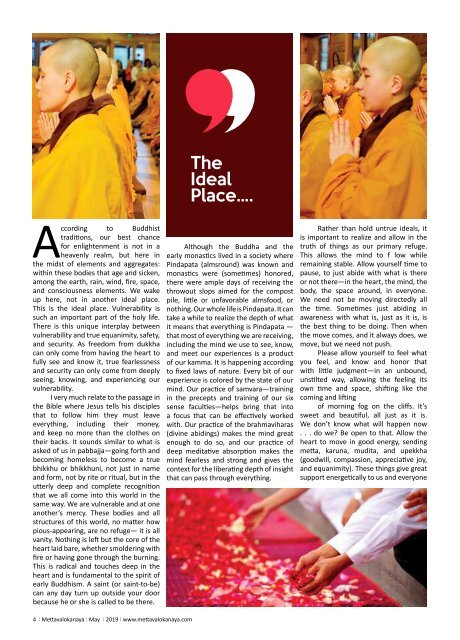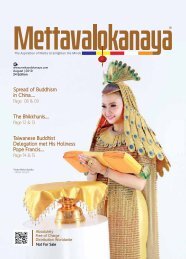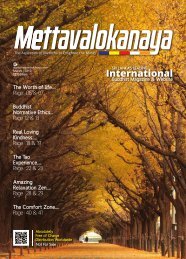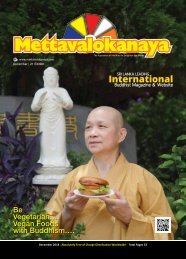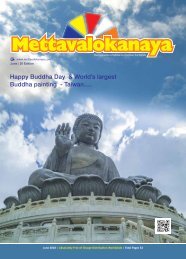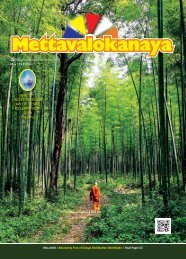Mettavalokanaya_International_Buddhist_Magazine_May_2019
“Mettavalokanaya” Sri Lanka’s leading & Most popular International Monthly Buddhist Magazine has been successfully distributed to 40 countries including all districts across Sri Lanka.
“Mettavalokanaya” Sri Lanka’s leading & Most popular International Monthly Buddhist Magazine has been successfully distributed to 40 countries including all districts across Sri Lanka.
Create successful ePaper yourself
Turn your PDF publications into a flip-book with our unique Google optimized e-Paper software.
According to <strong>Buddhist</strong><br />
traditions, our best chance<br />
for enlightenment is not in a<br />
heavenly realm, but here in<br />
the midst of elements and aggregates:<br />
within these bodies that age and sicken,<br />
among the earth, rain, wind, fire, space,<br />
and consciousness elements. We wake<br />
up here, not in another ideal place.<br />
This is the ideal place. Vulnerability is<br />
such an important part of the holy life.<br />
There is this unique interplay between<br />
vulnerability and true equanimity, safety,<br />
and security. As freedom from dukkha<br />
can only come from having the heart to<br />
fully see and know it, true fearlessness<br />
and security can only come from deeply<br />
seeing, knowing, and experiencing our<br />
vulnerability.<br />
I very much relate to the passage in<br />
the Bible where Jesus tells his disciples<br />
that to follow him they must leave<br />
everything, including their money,<br />
and keep no more than the clothes on<br />
their backs. It sounds similar to what is<br />
asked of us in pabbajja—going forth and<br />
becoming homeless to become a true<br />
bhikkhu or bhikkhuni, not just in name<br />
and form, not by rite or ritual, but in the<br />
utterly deep and complete recognition<br />
that we all come into this world in the<br />
same way. We are vulnerable and at one<br />
another’s mercy. These bodies and all<br />
structures of this world, no matter how<br />
pious-appearing, are no refuge— it is all<br />
vanity. Nothing is left but the core of the<br />
heart laid bare, whether smoldering with<br />
fire or having gone through the burning.<br />
This is radical and touches deep in the<br />
heart and is fundamental to the spirit of<br />
early Buddhism. A saint (or saint-to-be)<br />
can any day turn up outside your door<br />
because he or she is called to be there.<br />
The<br />
Ideal<br />
Place….<br />
Although the Buddha and the<br />
early monastics lived in a society where<br />
Pindapata (almsround) was known and<br />
monastics were (sometimes) honored,<br />
there were ample days of receiving the<br />
throwout slops aimed for the compost<br />
pile, little or unfavorable almsfood, or<br />
nothing. Our whole life is Pindapata. It can<br />
take a while to realize the depth of what<br />
it means that everything is Pindapata —<br />
that most of everything we are receiving,<br />
including the mind we use to see, know,<br />
and meet our experiences is a product<br />
of our kamma. It is happening according<br />
to fixed laws of nature. Every bit of our<br />
experience is colored by the state of our<br />
mind. Our practice of samvara—training<br />
in the precepts and training of our six<br />
sense faculties—helps bring that into<br />
a focus that can be effectively worked<br />
with. Our practice of the brahmaviharas<br />
(divine abidings) makes the mind great<br />
enough to do so, and our practice of<br />
deep meditative absorption makes the<br />
mind fearless and strong and gives the<br />
context for the liberating depth of insight<br />
that can pass through everything.<br />
Rather than hold untrue ideals, it<br />
is important to realize and allow in the<br />
truth of things as our primary refuge.<br />
This allows the mind to f low while<br />
remaining stable. Allow yourself time to<br />
pause, to just abide with what is there<br />
or not there—in the heart, the mind, the<br />
body, the space around, in everyone.<br />
We need not be moving directedly all<br />
the time. Sometimes just abiding in<br />
awareness with what is, just as it is, is<br />
the best thing to be doing. Then when<br />
the move comes, and it always does, we<br />
move, but we need not push.<br />
Please allow yourself to feel what<br />
you feel, and know and honor that<br />
with little judgment—in an unbound,<br />
unstilted way, allowing the feeling its<br />
own time and space, shifting like the<br />
coming and lifting<br />
of morning fog on the cliffs. It’s<br />
sweet and beautiful, all just as it is.<br />
We don’t know what will happen now<br />
. . . do we? Be open to that. Allow the<br />
heart to move in good energy, sending<br />
metta, karuna, mudita, and upekkha<br />
(goodwill, compassion, appreciative joy,<br />
and equanimity). These things give great<br />
support energetically to us and everyone<br />
around us, but we should not try to make<br />
anything happen any particular way—<br />
our way is openness and freedom in the<br />
truth of things.<br />
There is a growing and blossoming<br />
happening here in the Bhikkhuni Sangha.<br />
It is a wonderful time for those who like<br />
to be a part of such things. This time has<br />
its special uniqueness. There is so much<br />
joy in<br />
the discovery process of being<br />
a beginner; so much gladness in the<br />
compassion and understanding, and<br />
having what is good to share later on.<br />
It is all so worth it on this path. Check<br />
what’s going on. Is there Dhamma<br />
matching well with this circumstance?<br />
Consciously consider, recollect, and<br />
bring it up and you’ll be switched to a<br />
different mode. When we remember<br />
such Dhamma, when we turn on our<br />
conscious awareness, things shift. They<br />
change, especially if we’ve developed<br />
this practice. It happens quickly, so you<br />
want to develop it beforehand, like<br />
speed dial. The analogy I learned was<br />
warrior training—good warriors should<br />
know how to use all their weapons and<br />
skills before they go into battle. Practice<br />
beforehand and have them ready. Then,<br />
having survived the battle, bring what<br />
Sanghatheri, Preceptor, The<br />
Chief Founding Abbes of<br />
Dhammadharini Monastery<br />
& Senior Teacher in<br />
Residence at Aranya Bodhi<br />
Hermitage, California, USA<br />
Most Venerable Bhikkhuni<br />
Ayya Tathaloka Mahatheri<br />
USA<br />
“Let the<br />
Light Shine<br />
- Reflections<br />
from Theravada<br />
Bhikkhunis”….<br />
was learned back to the training ground.<br />
In this way, the training is further refined.<br />
Another image is of the Buddha’s<br />
words being likened to wildflowers<br />
gathered together as a bouquet, bound<br />
by string. The amazing assortment<br />
of wildflowers is us; the string is the<br />
Vinaya. The bouquet is beautiful and rich<br />
because of its variety and represents the<br />
strengths and memorable qualities of<br />
all the great monastic disciples. You are,<br />
in some sense, perfect just as you are.<br />
Unique kilesas (defilements) transformed<br />
by Dhamma become unique parami—<br />
qualities that pass through everything.<br />
What you will contribute to the Sangha,<br />
no one else can and the same is true of<br />
others around you. It is an incredible<br />
process of discovery.<br />
Please let examples of those who<br />
inspire you—the qualities within them,<br />
their embodiment, and presence—move<br />
deeply into your heart. Let them be<br />
your spiritual parents. Let their example<br />
create you and take birth and life in<br />
you. Their qualities are most important,<br />
not the person. If you are inspired by<br />
these qualities, you have them latent<br />
in yourself. Allow these examples to<br />
nurture and guide you. Compassion<br />
and understanding allow us to deeply<br />
appreciate the blessing and benefit of<br />
others while being true to our own way.<br />
This is right in the Sangha—like the field<br />
of various wildflowers bound by one cord<br />
that makes us all part of this enormous<br />
ancient and multifaceted intentional<br />
community.<br />
I would like to widen and deepen<br />
the intention to include personal<br />
support for all those involved who are<br />
experiencing difficulty, including the<br />
monastics and many supportive lay<br />
friends. If that were us on the other side,<br />
what would we hope for? What would be<br />
helpful and deeply beneficial? We might<br />
not immediately have answers, but it is<br />
good and important kamma to incline<br />
our minds in this way. Sometimes, in a<br />
search for answers to difficult questions,<br />
we find empty space more fruitful,<br />
which leads to exploring unfamiliar heart<br />
ground before the unknown beneficence<br />
we were hoping to find<br />
emerges. Sometimes this takes<br />
years of applying our mind, heart, and<br />
efforts so intently. It is well-spent time—<br />
worthy effort, not unworthy.<br />
I encourage delving deeply in this,<br />
not just dipping in and out and then<br />
walking away, because we are not yet<br />
proficient or not yet able to quickly and<br />
easily draw out what we were looking<br />
for—patient perseverance applied to<br />
emptying, seeing, knowing, and the wish<br />
to wisely and compassionately respond.<br />
There is sacrifice that is pure gift—no<br />
strings, no need for results to be any<br />
particular way, a pure dana (offering).<br />
Then there are other types of sacrifice—<br />
the kinds in which attachment plays a big<br />
role. I have found it good to train myself,<br />
repeatedly, from the small things to the<br />
large, to do what I am doing freely as<br />
an offering, otherwise, it can become a<br />
trap, a cage with an unfriendly animal<br />
inside that bites.<br />
It is important to sit with things—<br />
not to react quickly. Go to your kuti<br />
(hut) or into natural spaces and spend<br />
a few hours sitting. Let the process of<br />
reactions and responses go through<br />
their full spectrum of unfolding. What<br />
is left, glowing in the center after all the<br />
leaves have opened out, is excellent.<br />
I believe in all of you. This process of<br />
pausing, centering, grounding, and<br />
then looking deeper can reveal great<br />
things. It also leads to a steadiness and<br />
if practiced regularly, a sense of deep,<br />
ongoing steadiness. This steadiness and<br />
clarity are the heart of the path, the<br />
antithesis of dukkha. Steady with release<br />
and consistent moment by- moment<br />
mindfulness—clear, full awareness. I<br />
am finding the patterns of nature to be<br />
conducive as metaphors for meaning in<br />
life and the unfolding of this path—both<br />
the blossoms and fragrance of sweet<br />
springtime, now abundant, and the<br />
fires and frosts. Each with its season,<br />
its blessing, and its beauty. The fire<br />
tempering the blade, the frost giving<br />
rest and the time to go deep within, the<br />
springtime glory. The shadow providing<br />
cool shade, giving shape and definition<br />
illuminating the light.<br />
4 l <strong>Mettavalokanaya</strong> l <strong>May</strong> l <strong>2019</strong> l www.mettavalokanaya.com www.mettavalokanaya.com l <strong>2019</strong> l <strong>May</strong> l <strong>Mettavalokanaya</strong> l 5


